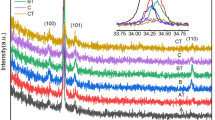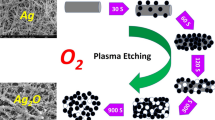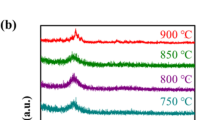Abstract
The effects induced by an external homogeneous magnetic field on the oxide film growth on aluminum in aqueous solutions of oxalic and sulfuric acid and on surface morphology of the alumina films were studied. Aluminum films of 100 nm thickness were prepared by thermal evaporation on SiO2/Si and glass-ceramic substrates. The pore diameter for oxalic acid alumina films on the SiO2/Si substrate decreased by 0.8 nm, the interpore distance by 5.9 nm, and cell diameter by 6.9 nm if a magnetic field of 0.5 T was applied. When aluminum was anodized in sulfuric acid on the same substrate, the significant changes in parameters of porous structure of alumina, which were similar to the ones in oxalic acid, are firstly observed in stronger magnetic fields (of 0.7 T). On the basis of data obtained in this study and of previous investigation on the negative space charge and thermally activated defects in anodic alumina, we concluded that the intensity of the magnetic field is associated with energy of electron traps and that the changes of cell diameter characterize the trap concentration. The energy of electron traps in oxalic acid alumina films was proved to be smaller than the one in films formed in sulfuric acid, but the concentration of traps was of the same order of magnitude. When the substrate was replaced with the glass-ceramic one, the pore diameter in oxalic acid alumina films increased to ca. 17.6 nm.







Similar content being viewed by others
References
Zaraska L, Sulka GD, Jaskuła M (2011) J Solid State Electrochem 15:2427–2436
Lee W, Park SJ (2014) Chem Rev 114:7487–7556
Kikuchi T, Nishinaga O, Natsui S, Suzuki RO (2015) Appl Surf Sci 341:19–27
Vrublevsky I, Jagminas A, Hemeltjen S, Goedel W (2009) J Solid State Electrochem 13:1873–1880
Ispas A, Bund A, Vrublevsky I (2010) Electrochim Acta 55:4180–4187
Takezawa M, Imagawa T, Yamasaki J, Yagi M (2007) Sens Lett 5:293–295
Ispas A, Vrublevsky I, Schmidt U, Bund A (2013) ECS Trans 50:141–146
Lohrengel MM (1993) Mater Sci Eng R11:243–294
Mozalev A, Mozaleva I, Sakairi M, Takahashi H (2005) Electrochim Acta 50:5065–5075
Baron-Wiecheć A, Burke MG, Hashimoto T, Liu H, Skeldon P, Thompson GE, Habazaki H, Ganem JJ, Vickridge IC (2013) Electrochim Acta 113:302–312
Shingubara S, Okino O, Sayama Y, Sakaue H, Takahagi T (1997) Jpn J Appl Phys 36:7791–7795
Shingubara S, Okino O, Sayama Y, Sakaue H, Takahagi T (1999) Solid State Electron 43:1143–1146
Aerts T, Dimogerontakis T, De Graeve I, Fransaer J, Terryn H (2007) Surf Coat Technol 201:7310–7317
Vrublevsky I, Jagminas A, Schreckenbach J, Goedel WA (2007) Electrochim Acta 53:300–304
Lambert J, Guthmann C, Ortega C, Saint-Jean M (2002) J Appl Phys 91:9161–9170
Hassel AW, Lohrengel MM (1995) Electrochim Acta 40:433–437
Akhiezer AI, Berestetskii VB (1965) Quantum electrodynamics. Wiley, New York
Vrublevsky IA, Chernyakova KV, Jagminas AI (2013) J Electrochem Soc 160:C285–C290
Vrublevsky I, Parkoun V, Sokol V, Schreckenbach J, Marx G (2004) Appl Surf Sci 222:215–225
Stępniowski WJ, Bojar Z (2011) Surf Coat Technol 206:265–272
Stępniowski WJ, Norek M, Michalska-Domańska M, Bojar Z (2013) Mater Lett 111:20–23
Ono S, Masuko N (2003) Surf Coat Technol 169–170:139–142
Acknowledgments
This work was undertaken under the cooperative project ТАР LB-12/2015 supported by Lithuanian and Belarusian Science Councils F15LIT-019.
Author information
Authors and Affiliations
Corresponding author
Electronic supplementary material
ESM 1
(RAR 21 MB)
Rights and permissions
About this article
Cite this article
Vrublevsky, I., Ispas, A., Chernyakova, K. et al. Effect of continuous magnetic field on the growth mechanism of nanoporous anodic alumina films on different substrates. J Solid State Electrochem 20, 2765–2772 (2016). https://doi.org/10.1007/s10008-016-3274-8
Received:
Revised:
Accepted:
Published:
Issue Date:
DOI: https://doi.org/10.1007/s10008-016-3274-8




